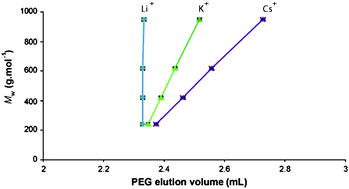Effect of salt in the mobile phase on the critical conditions of poly(ethylene glycol) in liquid chromatography-mass spectrometry coupling
Abstract
The nature of salts introduced in the chromatographic

* Corresponding authors
a
Universités Aix-Marseille I, II et III – CNRS, UMR 6264: Laboratoire Chimie Provence, Spectrométries Appliquées à la Chimie Structurale, Marseille, France
E-mail:
laurence.charles@univ-provence.fr
Fax: +33 4 91 28 28 97
Tel: +33 4 91 28 86 78
b Universités Aix-Marseille I, II et III – CNRS, UMR 6264: Laboratoire Chimie Provence, Chimie Radicalaire, Organique et Polymères de Spécialité, Marseille, France
The nature of salts introduced in the chromatographic

 Please wait while we load your content...
Something went wrong. Try again?
Please wait while we load your content...
Something went wrong. Try again?
M. Girod, E. Beaudoin and L. Charles, Anal. Methods, 2009, 1, 128 DOI: 10.1039/B9AY00118B
To request permission to reproduce material from this article, please go to the Copyright Clearance Center request page.
If you are an author contributing to an RSC publication, you do not need to request permission provided correct acknowledgement is given.
If you are the author of this article, you do not need to request permission to reproduce figures and diagrams provided correct acknowledgement is given. If you want to reproduce the whole article in a third-party publication (excluding your thesis/dissertation for which permission is not required) please go to the Copyright Clearance Center request page.
Read more about how to correctly acknowledge RSC content.
 Fetching data from CrossRef.
Fetching data from CrossRef.
This may take some time to load.
Loading related content
